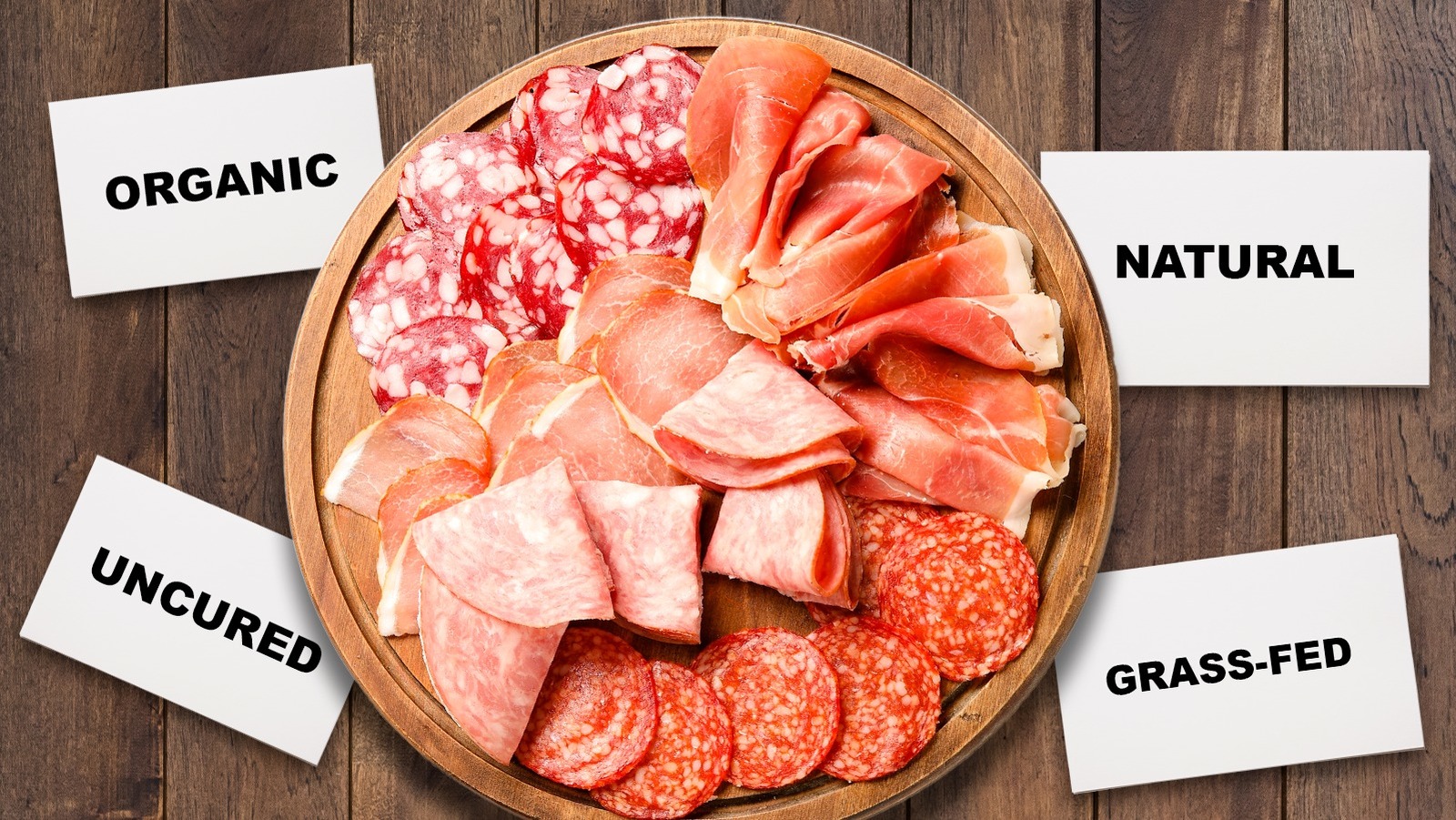Part of being a smart shopper is paying attention to the labels on packaged foods. They carry a lot of information, some of it factual and some of it purely marketing. As a rule, the more processed a food is, the more information you’ll find on the label. A steak from the supermarket is usually just labeled with its weight, price, and packing and use-by dates. Heavily-processed foods have much more detailed labels, reflecting all of the ingredients they contain. Deli meats fall in between those extremes, having just enough ingredients to make parsing the labels worthwhile.
I’m a trained chef (and former food safety instructor), and I also grew up with a father who was seriously into homegrown foods. So I’ve had all the motivation I needed to learn which parts of deli meat labels are meaningful and which are just marketing ploys. Here are a dozen things you might see on deli meat labels and what they actually mean.
Organic
The USDA’s “Certified Organic” logo on a pack of deli meat is one of the most tightly-regulated certifications in consumer foods. But it doesn’t necessarily mean what you think it does, and the different terms on organic food labels have specific meanings.
The most meaningful label is “100% organic,” which means that every single ingredient used in the deli meat is, in itself, certified organic. “But wait,” you may ask, “Isn’t that what ‘Certified Organic’ already means?” Well … no. Your organic food may not be fully organic, because the standard certification allows up to 5% of the ingredients to be non-organic, with some limitations. Then there’s “made with organic ingredients,” which allows up to 30% of a food’s contents to be non-organic.
For deli meats to carry the USDA certified organic logo, they must meet specific regulations regarding how the animals are raised and how the meats are cured. So there’s definitely a bit of wiggle room in terms of how “organic” your organic deli meats are. Also, while the USDA tightened enforcement of organic labeling in 2024, it’s unclear whether the agency will have the resources to enforce its rules consistently.
Natural
There are some labeling terms I tend to be cynical about, and “natural” is one of them. For most foods, “natural” can mean whatever the manufacturer wants it to mean — and, let’s face it, “natural” and “manufacturer” are concepts that don’t fit comfortably together.
Meats and poultry are an exception to this general rule. The USDA does have some standards for the use of the term “natural,” but they’re rather underwhelming. Basically, any label using the word “natural” has to state what makes it natural — the USDA says an example of a qualifying statement could be something like, “minimally processed, no artificial ingredients.” This also allows producers to use flavorings in food, as long as the flavoring is minimally processed and couldn’t be considered artificial.
It’s a low bar, if we’re being honest. There’s not a lot of transparency about what “natural flavors” means in your food, and “minimally processed” is a vague phrase that gives companies a lot of leeway. If you’re comparing natural and organic in the deli meats aisle, there’s no contest. Organic is a much more meaningful term, while “natural” is all about the vibes and the marketing.
Gluten-free
You might be surprised to find a gluten-free claim (or certification logo) on a package of deli meats. Meat is naturally gluten free, so it feels like one of those silly bandwagon-jumping marketing ploys like labeling mashed potatoes as “plant-based.”
The reality is different, because deli meat isn’t just meat. It’s meat that’s been processed and includes bunch of additives to tweak its texture, flavor, shelf life and color. That’s where the mischief comes in, because a lot of those ingredients may contain gluten in some form or other. That’s why deli meats are among the surprising number of common foods that aren’t gluten free, even when you think they should be (or at least, aren’t necessarily gluten free).
So yes, if you’ll be serving anyone with celiac disease or a diagnosed gluten intolerance (just as painful, but without the permanent gut damage; my own daughter falls into that category), you should be buying deli meats that explicitly state they’re gluten free. The amount of gluten in deli meats may or may not be high enough to matter, but better safe than sorry.
Uncured, or naturally cured
This is a term that I’m seeing on a lot of deli meats over the past few years, as well as other kinds of processed meats like bacon or even hot dogs. This one requires a bit of explanation, so bear with me.
Many deli meats, as well as hams, bacon, and hot dogs, are “cured” with a mixture of salt, sugar, flavorings, and what’s called “curing salt.” That contains some combination of nitrates and nitrites, which provide long-term protection against bacterial activity and also help give hams and bacon their attractive pink color. Unfortunately they’re also carcinogens, which is why there’s a well-established link between charcuterie and cancer (sob!).
So, if meats are cured to prevent dangerous bacteria, what’s the difference between cured and uncured bacon, or deli meats, or anything else? How do they stay safe? Well, the honest answer is that “uncured” deli meats are still cured, but they get their nitrates from a natural source like celery. There’s no evidence that this mitigates the cancer risk, so on the whole (to be clear, this is my personal take) I’m happier using curing salt.
Reduced or lower-sodium
Deli meats are convenient, tasty, and versatile. There’s a lot to love about them (especially the “tasty” part), but if there’s one single complaint that applies broadly to deli meats it’s their generally high sodium levels. It mostly comes from salt, which is added partly for flavor but largely as a preservative and part of the curing process. That makes sodium levels a concern for a lot of us, either because of specific medical conditions (like edema or high blood pressure) or a general interest in healthier eating.
The thing is, there’s a difference between low sodium and reduced sodium. “Low sodium,” “very low sodium” and “zero sodium” all have very specific legal meanings: they mean a food contains less than (respectively) 140 milligrams, 35 mg, or 5 mg in a standard-sized portion. That’s clear, and meaningful.
“Reduced” or “lower” sodium claims on a label are a whole other ball game, because those terms aren’t as clearly defined. They just mean that particular meat contains less sodium than the “regular” version, which can vary between brands. So it’s entirely possible (even probable) that one company’s “reduced” version is actually higher in sodium than another company’s regular version.
Healthy
“Healthy” is another term, like “natural,” that always makes me take a really close look at a product. It’s not entirely meaningless, to be clear, but it probably doesn’t mean as much as you think it does.
According to FDA guidance (as of 2024) to use the term “healthy,” a food must “contain a certain amount of food” from one of the designated food groups recommended in the current Dietary Guidelines for Americans, and “meet specific limits” for saturated fat, sodium, and added sugars. So what does that mean for deli meats? Well, it means they contain an acceptable level of the good stuff (relatively lean meat or poultry), and don’t go over the legal limit on the bad stuff.
It sounds good enough, and it’s better than nothing, but as a meaningful distinction between deli meats it’s not all it could be. The FDA’s standards for fat, sugar and sodium were set “in consultation” with the industry (meaning they were lobbied), and any use of the term “healthy” is purely voluntary. So, as these things go, this one falls mostly into the marketing category.
No added hormones
If you’re concerned about eating healthy foods, “no added hormones” is a label claim that you might specifically look for. Although the hormones used in the food chain are subjected to a high level of regulatory scrutiny, it’s not possible to be completely certain what cumulative impact they might have.
So if you’re scoping out a package of pastrami, corned beef, or even some deli-style roast beef for sandwiches, that’s a term you’ll be happy to find on the package. This is because it’s perfectly legal in the U.S. for cattle to be fed bovine growth hormone to help them pack on weight (and thereby boost profits). If the label says it’s hormone-free, you won’t be consuming any of that hormone yourself or feeding it to your kids.
If you think you hear a “but” coming, you’re right. This is a common phrase on beef packages, but sometimes you’ll also see it on deli meats made from pork or poultry. The thing is, U.S. regulations don’t permit the use of hormones in pork or poultry production, so a “no hormones” label on your salami or your sliced chicken breast is pretty meaningless, and purely for marketing.
Grass-fed or pastured
There’s a whole big debate among foodies about beef that’s grass-fed or grass-finished, and how it compares to conventional beef. Ordinary beef comes from animals that start their lives eating grass, but then are sent to feedlots where they’re stuffed full of as much grain as they’ll eat. This bulks them up in a hurry and fills them with extra fat, better known as marbling, which is the key to how beef cuts are graded.
Grass-fed beef is leaner, and some aficionados favor it because it has less saturated fat and higher levels of omega-3 fatty acids. Unfortunately “grass-fed” is another one of those unenforceable terms, because most animals are grass-fed at some part of their lives. So “grass-finished” is the term to look for if you want the beef in your deli meats to have the desired fat profile (or if animal welfare is your issue).
The corresponding terms for pork and poultry include phrases like “pastured,” or for poultry specifically you might also see “free range” or “free run.” Again, there’s a thicket of regulations surrounding what those claims mean, and grocery store chicken labels in particular may not mean what you think, whether you’re buying your chicken fresh or in deli meat form. If animal welfare is your priority, third-party brand reviews or inspections will tell you more than the product’s own label.
Reduced or lower-fat
The criteria for using the “healthy” claim on a deli meat’s label often concern its fat content. That’s not an issue for something like sliced roast beef, which is pretty lean, but it comes up in a lot of charcuterie and other processed meats whose fat content can be more variable.
This is why you’ll sometimes see phrases like “reduced fat” or “lower fat” on the packaging for your deli meats. If you think back to our discussion of sodium, and guess that these are also measured relative to “our comparable full-fat product,” you’d be right. It’s not as meaningful as “low fat,” “very low fat,” or “no fat,” which again all have legally-defined limits based on a standardized portion.
This isn’t an issue for deli meats that are based on lean cuts to begin with, but of course those aren’t usually the ones that get “reduced fat” labeling anyway. So it’s worth noting that when a normally-fatty deli meat is available in a lower-fat version, other ingredients are often added to recreate the original product’s normal taste, texture, and mouthfeel. Those ingredients themselves may not be especially desirable or good for you, which is why unhealthy low-fat foods are definitely a thing.
Best by/use by dating
So far the parts of a label we’ve looked at have focused on the ingredients or nutritional values of deli meats, or how the animals were raised. Now we’re going shift gears a bit and look at a couple of other elements of the label that are pertinent in different ways.
So let’s talk about those “best by” or “use by” dates, shall we? To be clear, these aren’t “expiration” dates and your deli meat doesn’t go from perfectly good to downright dangerous overnight. That date is the manufacturer’s estimate of how long the product will retain its best flavor and quality. Of course, manufacturers have multiple incentives to be super conservative with those dates: it ups their profits, minimizes the risk of liability, and so on (interestingly, notorious gangster Al Capone pushed for expiration dates almost a century ago).
In reality, your unopened lunch meat lasts a while in the fridge. As long as it came straight home from the supermarket and went right into your fridge without warming up, the USDA says deli meat is good for up to two weeks. Once it’s opened, that changes things. Opened deli meats are good for 4-5 days at best, and less if you’ve been careless about leaving them out at room temp after making your sandwiches.
Allergen warnings
Here’s something you may never even notice or think about unless you or someone in your household is diagnosed with a food allergy. If you deal with food allergies on a daily basis you don’t need me to tell you how this works. For everyone else it’s still worth talking about, if only because at some point you’ll probably need to feed someone with allergies. So let’s dig into these.
First, let’s be clear: Allergen disclosure statements are required by law. If a deli meat contains any of the so-called “big eight” allergens (soy, wheat, eggs, milk, fish, shellfish, tree nuts, or peanuts), they must be disclosed on the label. This sometimes leads to absurdities — like Costco recalling tons of butter that was missing a “contains milk” warning — but it’s potentially life-saving for people with allergies.
There are some variations, and deli meats imported from other jurisdictions may list different allergens. For example, I live in Canada, where we label for sulphites and mustard as well as the “big eight”. There’s also the milder “may contain” statement, which means the deli meat isn’t formulated to include the allergen, but that it may be exposed to a modest degree of cross-contamination because those allergen ingredients are used elsewhere in the same production facility. Cross-contamination may or may not be an issue, depending how sensitive you (or your guest) are to that specific allergen.
Ingredients and nutrition labels
I’m going to finish up with the nutrition label and ingredients list on your deli meats, because they are, in their way, the ultimate reality check for all of those other sometimes-blurred terms. No matter which trendy phrases manufacturers promote on the front of the label, these small-print sections are where smart shoppers focus their attention (I now carry reading glasses when I shop for exactly this reason).
Ingredient and nutrition labels are mandatory, and their contents are defined by a thicket of laws and regulations that are outside the scope of today’s article. My focus here is that they’re your “second opinion,” after the sales-oriented front label. So for example, if the front calls a deli meat “natural” but the ingredients label on the back is filled with 10-syllable additives and preservatives, you may conclude that it probably doesn’t conform to your definition of natural.
Similarly, nutrition labels break down how much of the “good” stuff you get (protein, vitamins, minerals) as well as the “bad” stuff (calories, saturated fat, sodium). They also allow you to do an apples-to-apples comparison of regular and “lower-sodium” or “lower-fat” products to determine which is the best choice. Also, check the portion size when comparing labels. There is a process for determining the serving size, but sometimes products use different portion sizes (which throws off your comparison), or the portion size may be unrealistic for you personally. It changes the math, and may change your purchase decision.





